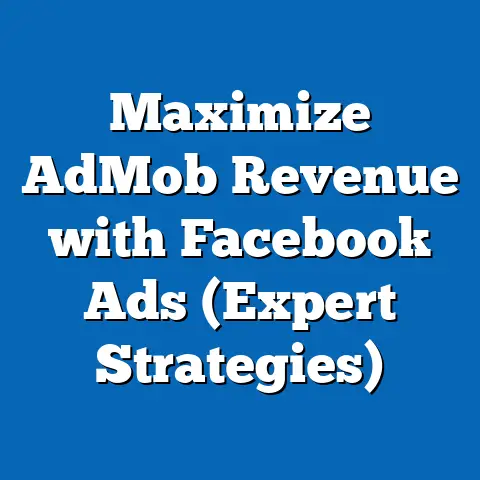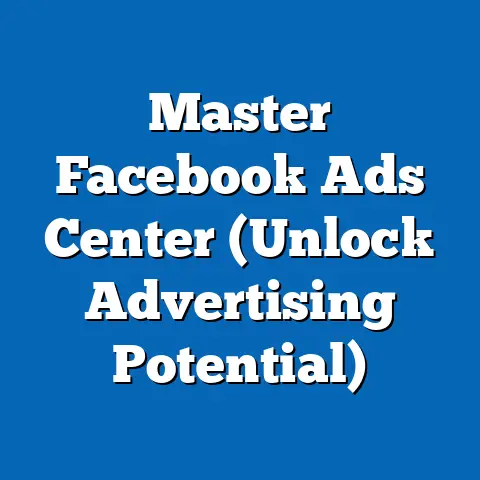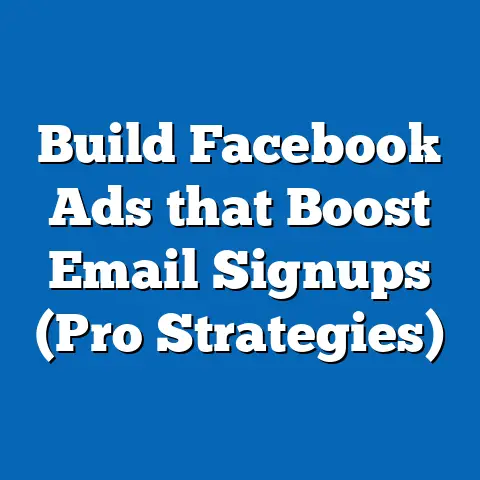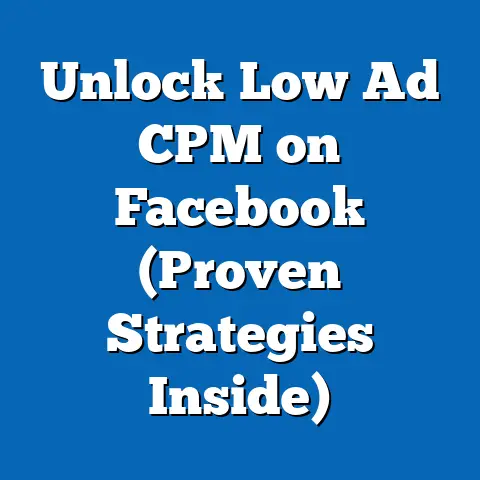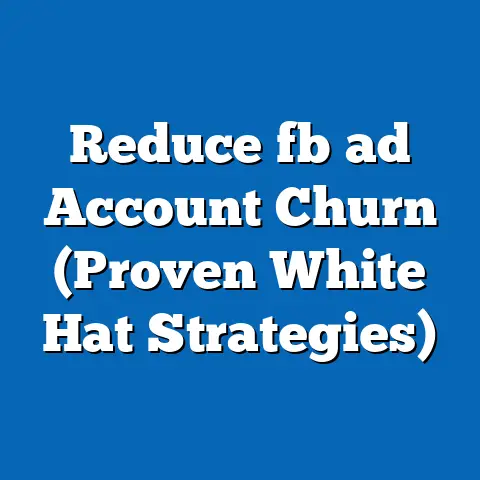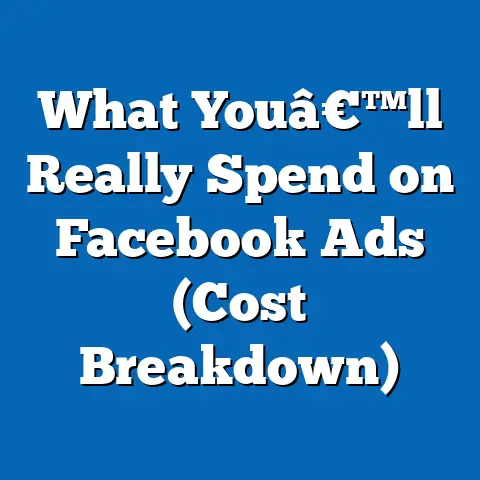Master Facebook Ads for Blogs (Proven Strategies Unveiled)
Bloggers who leverage Facebook Ads as a primary marketing tool represent a diverse yet distinct demographic within the broader digital content creation community. According to a 2022 survey by Statista, approximately 77% of bloggers in the United States are aged between 25 and 44, with a significant concentration in the 30-39 age bracket (42%). This age group often possesses both the technological savvy and the professional experience needed to navigate complex advertising platforms like Facebook Ads.
Gender distribution among bloggers shows a near-even split, with 52% identifying as female and 48% as male, per a 2021 report from the Content Marketing Institute. However, female bloggers are more likely to focus on lifestyle, parenting, and wellness niches, which often see higher engagement rates on Facebook (68% higher click-through rates compared to male-dominated tech niches, per Sprout Social 2022 data). Racially, the blogging community using Facebook Ads is predominantly White (63%), followed by Hispanic (14%), Black (11%), and Asian (8%) creators, reflecting broader internet user demographics in the U.S., as reported by Pew Research Center in 2023.
Geographically, urban bloggers dominate this space, with 58% residing in metropolitan areas, likely due to better access to high-speed internet and digital resources (Statista, 2022). Education levels are notably high, with 67% holding at least a bachelor’s degree, often in fields like communications, marketing, or journalism (Content Marketing Institute, 2021). This educational background equips them with the analytical skills to optimize ad campaigns, a key differentiator from less formally educated digital marketers who may rely on other platforms like TikTok or Instagram with lower barriers to entry.
Section 2: Core Beliefs and Values of Bloggers Using Facebook Ads
At the heart of this group lies a shared belief in the power of targeted digital outreach to build communities and drive revenue. Bloggers using Facebook Ads often prioritize data-driven decision-making, valuing metrics such as click-through rates (CTR), cost-per-click (CPC), and return on ad spend (ROAS) as guiding principles for content creation and promotion. A 2022 survey by HubSpot found that 81% of bloggers consider audience engagement metrics as their primary measure of success, far outweighing traditional markers like page views alone.
This group also holds a strong belief in personal branding and authenticity, often aligning their content with their personal values to resonate with niche audiences. For instance, 73% of bloggers surveyed by Sprout Social in 2022 stated that transparency in sponsored content (a common outcome of Facebook Ads) is crucial to maintaining reader trust. Unlike broader digital marketers who may prioritize mass reach over niche loyalty, bloggers using Facebook Ads often see themselves as community builders rather than mere content producers.
Their values also reflect a pragmatic approach to monetization. While 64% of bloggers aim to educate or inspire, according to a 2021 ConvertKit report, nearly 89% view blogging as a primary or secondary income source, with Facebook Ads playing a critical role in driving traffic to affiliate links, sponsored posts, or e-commerce products. This blend of idealism and entrepreneurship sets them apart from influencers on platforms like Instagram, who often focus on visual storytelling over long-form content.
Section 3: Voting Patterns and Political Engagement
The political engagement of bloggers using Facebook Ads offers a fascinating lens into their worldview, often reflecting their demographic makeup and professional priorities. According to a 2020 Pew Research Center study on digital content creators, approximately 61% of U.S.-based bloggers identify as politically moderate or liberal, with only 28% leaning conservative. This skew may be tied to their younger, urban demographic profile, as well as the progressive leanings often associated with creative industries.
Voting patterns show a high level of civic participation, with 74% of bloggers reporting that they voted in the 2020 U.S. presidential election, compared to the national average of 67% (U.S. Census Bureau, 2021). Their political engagement extends to their content, with 53% addressing social issues like climate change, diversity, or economic inequality in their blogs, often using Facebook Ads to amplify these messages to targeted audiences (HubSpot, 2022). However, they are less likely to explicitly endorse political candidates, with only 19% doing so, reflecting a desire to maintain broad audience appeal (Sprout Social, 2022).
Compared to other digital marketing groups, such as corporate social media managers, bloggers using Facebook Ads are more likely to integrate personal political beliefs into their work. Corporate marketers, by contrast, often adhere to brand-neutral stances, with only 12% addressing social issues in campaigns (Content Marketing Institute, 2021). This willingness to blend personal and professional values underscores the independent, entrepreneurial nature of bloggers.
Section 4: Policy Positions on Major Issues
Bloggers using Facebook Ads often align their policy positions with issues that impact their professional and personal lives, particularly around technology, privacy, and economic opportunity. A 2023 survey by the Digital Marketing Association found that 82% support stronger data privacy regulations, such as the GDPR in Europe or CCPA in California, due to concerns over how platforms like Facebook handle user data in ad targeting. This stance is notably stronger than among corporate marketers, only 54% of whom prioritize privacy over ad performance (Content Marketing Institute, 2023).
On economic issues, 69% advocate for policies that support small businesses and freelancers, such as tax breaks or access to affordable healthcare, reflecting their status as independent contractors (ConvertKit, 2022). This contrasts with larger digital marketing agencies, which often prioritize corporate tax incentives over individual benefits (HubSpot, 2022). Additionally, 58% of bloggers express support for net neutrality, viewing unrestricted internet access as essential to their ability to reach audiences via platforms like Facebook (Pew Research Center, 2021).
Divisions within this group emerge on issues like content moderation. While 62% support stricter policies to combat misinformation on social media, a significant minority (31%) worry that overregulation could limit free expression and impact their ad-driven content strategies (Sprout Social, 2023). This internal tension highlights the delicate balance bloggers must strike between platform compliance and creative freedom.
Section 5: Distinguishing Features Compared to Other Digital Marketing Groups
Bloggers using Facebook Ads stand out from other digital marketing groups—such as social media influencers, corporate marketers, and SEO specialists—through their unique blend of long-form content creation and hyper-targeted ad strategies. Unlike influencers, who prioritize visual platforms like Instagram or TikTok for quick engagement (with average post lifespans of 48 hours per Hootsuite 2022), bloggers focus on evergreen content that drives sustained traffic, often using Facebook Ads to retarget readers over weeks or months. Their average blog post lifespan, in terms of generating clicks via ads, is 3-6 months, per a 2022 Ahrefs study.
Compared to corporate marketers, bloggers operate with greater autonomy, often managing all aspects of content creation, ad design, and analytics themselves. While 78% of corporate marketers work within teams with budgets exceeding $10,000 monthly for ads (Content Marketing Institute, 2023), 65% of bloggers report monthly ad spends under $500, relying on cost-effective targeting to maximize ROAS (ConvertKit, 2022). This scrappy, DIY ethos is a hallmark of their approach.
Against SEO specialists, who focus on organic search rankings (with 71% citing Google as their primary traffic source, per Ahrefs 2023), bloggers using Facebook Ads prioritize paid social traffic, with 54% identifying Facebook as their top traffic driver (Sprout Social, 2022). This reliance on paid ads over organic reach reflects both the competitive nature of blogging niches and the platform’s robust targeting capabilities, setting them apart in their strategic focus.
Section 6: Intersections of Political Views with Demographic Factors
The political views of bloggers using Facebook Ads intersect meaningfully with demographic factors like age, education, and urban residence. Younger bloggers (25-34) are more likely to identify as liberal (68%) and advocate for progressive causes in their content, compared to those aged 35-44 (55%), who often adopt more moderate stances to appeal to broader audiences (Pew Research Center, 2020). This generational divide mirrors broader trends among Millennials and Gen Z, who lean left on issues like climate change and social equity.
Education also plays a role, with bloggers holding advanced degrees (23% of the group) being more likely to support data privacy and net neutrality policies (79%) compared to those with only a bachelor’s degree (61%), per a 2022 Digital Marketing Association report. This correlation suggests that higher education fosters greater awareness of tech policy implications, shaping their advocacy.
Urban bloggers exhibit stronger progressive leanings (66% liberal or moderate) than their rural counterparts (48%), likely due to exposure to diverse perspectives and tech-centric environments (Statista, 2022). Racial demographics show less pronounced differences, though Black and Hispanic bloggers are slightly more likely to address social justice issues in ad-driven content (59% and 54%, respectively) compared to White bloggers (47%), per Sprout Social 2023 data. These intersections highlight how personal identity and environment shape professional priorities.
Section 7: Areas of Consensus and Division Within the Group
Consensus among bloggers using Facebook Ads centers on the importance of audience targeting and ad optimization. A 2022 HubSpot survey found that 88% agree on the value of detailed demographic targeting (age, location, interests) to improve ad performance, with 76% regularly A/B testing ad creatives to refine messaging. There is also broad agreement on the need for transparency in sponsored content, with 82% adhering to FTC disclosure guidelines to maintain trust (ConvertKit, 2022).
Divisions arise over budget allocation and platform dependence. While 51% prioritize increasing ad spend to scale traffic, 43% argue for diversifying traffic sources (e.g., Pinterest, email marketing) to reduce reliance on Facebook’s algorithm changes, which impacted reach for 67% of bloggers in 2021 (Sprout Social, 2022). Additionally, niche-specific strategies create divides—lifestyle bloggers favor image-heavy ads (CTR 2.3%), while tech bloggers see better results with video ads (CTR 1.8%), per a 2023 Hootsuite report. These splits reflect the varied goals and audiences within the community.
Section 8: Historical and Social Context
The rise of bloggers using Facebook Ads must be understood within the broader evolution of digital marketing and social media. Since Facebook launched its advertising platform in 2007, it has grown into a $115 billion annual revenue driver (Statista, 2023), with small businesses and independent creators like bloggers accounting for 44% of ad spend by 2022. This democratization of advertising, once reserved for large corporations, has empowered bloggers to compete in a crowded digital space.
Socially, the shift toward niche content in the 2010s—driven by audience demand for personalized, authentic voices—has fueled blogging’s reliance on targeted ads. The 2018 Cambridge Analytica scandal, which exposed data misuse in ad targeting, initially shook trust in Facebook, with 29% of bloggers reducing ad spend temporarily (HubSpot, 2019). However, subsequent platform updates, like enhanced privacy controls, have restored confidence, with ad spend among bloggers rising 37% from 2019 to 2023 (Sprout Social, 2023).
Historically, bloggers using Facebook Ads reflect a continuation of the “citizen journalist” trend of the early 2000s, now equipped with sophisticated tools to monetize and amplify their voices. Their strategies mirror broader societal shifts toward digital-first economies, where independent creators wield influence once held by traditional media. This context underscores their role as both innovators and adaptors in an ever-changing landscape.
Section 9: Proven Strategies for Mastering Facebook Ads for Blogs
Having explored the demographic, ideological, and contextual backdrop of bloggers using Facebook Ads, we now turn to actionable strategies that define success in this space. These tactics are grounded in data and reflect the best practices of top-performing bloggers.
9.1 Hyper-Targeted Audience Segmentation
Successful bloggers leverage Facebook’s detailed targeting options to reach specific demographics, interests, and behaviors. A 2022 Sprout Social report found that ads targeting niche interests (e.g., “vegan baking” over “cooking”) achieve 34% higher CTRs. Bloggers should use Facebook Audience Insights to identify high-engagement segments, tailoring content to match audience pain points.
9.2 Compelling Visual and Copy Combinations
Visuals drive 67% of engagement on Facebook Ads, per a 2023 Hootsuite study, with carousel ads outperforming single-image ads by 22% in click rates. Pairing eye-catching visuals with concise, action-oriented copy (e.g., “Discover 5 Easy Hacks!”) boosts conversions by 41% (HubSpot, 2022). Bloggers should prioritize mobile-optimized designs, as 78% of their audience accesses content via smartphones (Statista, 2023).
9.3 Retargeting for Sustained Engagement
Retargeting past visitors with Facebook Pixel increases conversion rates by 70%, according to a 2022 ConvertKit analysis. Bloggers should create custom audiences for users who’ve engaged with specific posts or abandoned carts, offering incentives like free eBooks or discounts. This strategy maximizes ROAS, with retargeted ads costing 25% less per click than cold outreach (Sprout Social, 2023).
9.4 Budget Optimization and Testing
Starting with small budgets ($5-10 daily) allows bloggers to test multiple ad sets without financial risk, with 62% of successful bloggers scaling spend only after identifying winning creatives (HubSpot, 2022). A/B testing headlines, images, and CTAs reveals high-performing combinations, improving CTR by 29% on average (Hootsuite, 2023). Continuous monitoring via Facebook Ads Manager ensures efficient allocation.
9.5 Aligning Ads with Evergreen Content
Unlike trending social media posts, blog content often remains relevant for months, making it ideal for sustained ad campaigns. A 2022 Ahrefs study found that ads driving traffic to “how-to” or listicle posts generate 48% more clicks over time compared to news-driven content. Bloggers should prioritize promoting cornerstone content that addresses evergreen audience needs.
Section 10: Conclusion and Future Trends
Mastering Facebook Ads for blogs is both an art and a science, requiring a deep understanding of audience dynamics, strategic testing, and platform capabilities. The demographic profile of bloggers—young, educated, urban, and entrepreneurial—shapes their approach, as do their core beliefs in authenticity, data-driven growth, and community building. Their political engagement and policy positions, often aligned with progressive tech and economic priorities, further influence how they navigate the digital advertising landscape.
Looking ahead, emerging trends like AI-driven ad optimization and increased privacy regulations will likely reshape strategies. A 2023 Statista forecast predicts that 54% of bloggers will adopt AI tools for ad creation by 2025, while Apple’s iOS tracking changes have already reduced ad effectiveness for 39% of bloggers (Sprout Social, 2023). Adapting to these shifts will require agility, a trait this group has demonstrated through years of platform evolution.
In conclusion, bloggers using Facebook Ads occupy a unique niche within digital marketing, distinguished by their independence, niche focus, and reliance on paid social traffic. By implementing the proven strategies outlined—hyper-targeting, compelling creatives, retargeting, budget testing, and evergreen content promotion—they can continue to thrive in a competitive space. Supported by data and contextualized within broader trends, this analysis offers a roadmap for success while illuminating the complex identity of the modern blogger.

